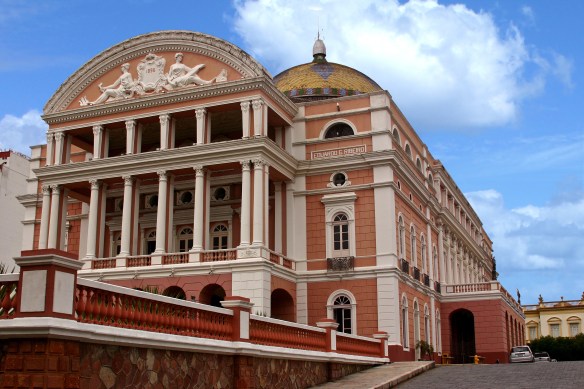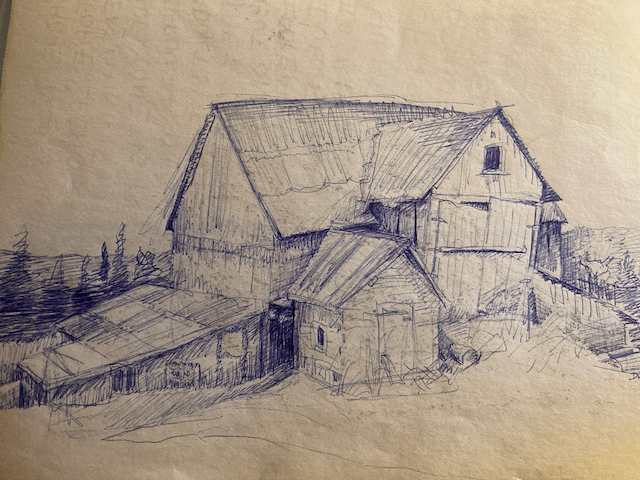
It was the fall of 2001 and the Los Angeles Times said that the Titan Arum (the Corpse Flower or Stinky Flower) would be blooming at the Huntington Gallery in San Marinoo only today. It was one of the largest flowers in the world and bloomed only every five years and only for three days. Twenty two years ago, there were many fewer of them in the world, but the Huntington had snaffled one. Yesterday, it had been at its best. Today would be the last chance to see it in flower. Tomorrow, the flower would wilt and die

I explained this to my grandson GS who was eating his breakfast at the other side of the tiny table. I did not call it a Corpse Flower. I called it a Stinky Flower. Six-year-old boys like gross, in moderation. Why did it smell bad? To attract flies to pollinate it. A few minutes of negotiation convinced his mother who was hurrying out to work that a school called Play Mountain Place would not disapprove of a day off to study a rare botanical specimen.
So we set off in my green Toyota Tercel from our barrio off Venice Blvd. I had just had major surgery and had come down from Canada to recover. The surgeon had recklessly removed my courage along with the part I had signed up for. I was no longer a road warrior on strange freeways. If I got confused, GS sitting behind me in his child seat, calmly pointed out where I should go.
The last thing my daughter said to me, “Oh, the Blue Boy is there. Be sure to see him.”
There was a very long line and it was hot in the sun, despite the free bottles of water. At certain points the smell of – let’s be frank – dead animal was overwhelming.
Then we went to lunch. Fortunately, a docent sitting at the next table was delighted to answer all the probing questions I couldn’t. Both of GS’s grandfathers were physicists and mathematicians. One of them had a double PhD. The other was my ex-husband.
After lunch, we looked at pictures. I was distracted by the blonde bombshell at my side. I had lost him in major airports, where I had to choose between catching him and losing our luggage. I still had him.
GS was close by my side when I walked into a room and there was the Blue Boy. I was so gobsmacked that I loosened my grip on my grandson’s hand. He slipped silently away. When I tore my eyes away from the full length portrait of the Boy in Blue, I saw a small being at the end of the room engrossed in the portrait there.
There was no one else there. Even the watcher had stood up from her chair and stepped around the corner. I wanted to stand there forever.
But I heard, “Can we go now? I’ve seen them all.”
It wasn’t enough. I had to go back the next day, without my mercurial companion.
As I passed the Titan Arum, I saw that it was a sad memory of its former glory.
I bought a small book about the Thomas Gainsborough’s Blue Boy (est. 1770) and and Sir Thomas Lawrence’s Pinkie (1793). The lithe girl hung opposite the Blue boy. Both people depicted are young, and Henry E. Huntington bought them both in the 1920s; otherwise, there is no connection between them.
Pinkie’s pink bonnet strings and her filmy white dress, with the wide pink sash are lifting in the breeze. Her pink lips are small, demure, kissable. A week before the portrait was to be exhibited at the royal Academy Exhibition, Pinkie died. She had had a cough, which may indicate she died of tuberculosis. The portrait vanished from view for many years, but it was known to be in the possession of Pinkie’s brother, the father of the poet, Elizabeth Barrett-Browning.
The little book The Blue Boy and Pinkie by Robert R. Wark, a ‘noted art historian’ was published by the Huntington Gallery in 1963. Wark gives the standard 1963 account of who modeled for the portrait. Indeed the print that I bought has the name in script at the bottom of the white window mat, Master Jonathan Buttall, the son of a wealthy ironmonger (hardware merchant). It is probable Gainsborough became a friend of the elder Buttall in Ipswich where they both lived before moving to London. Gainsborough was only 11-years-older than Master Buttall. We know they were friends because the artist left a short list of those he wanted at his funeral in 1788, including Jonathan.
Henry Huntington paid $728,000 for the Blue Boy in 1921. It is estimated to be worth over $9 billion today.
In the 1790s, Buttall’s business came upon hard times and his household effects were sold at auction, including the Blue Boy for 35 guineas. He died late in 1805 at the age of the age of 53, in which case, he would have been born in 1752. The portrait seems to have been exhibited in at the Royal Academy in 1770, which would have made Jonathan eighteen
When I sat down to write this blog post, Google did not agree with Robert R Wark, noted art historian though he was. Today’s noted art historians suggest it was Gainsborough Dupont, Thomas’s nephew, or, just to be awkward, that there was no sitter.
We know that a Van Dyke Costume such as the Blue Boy is wearing was available for Gainsborough’s sitters. The Honourable Edward Bouverie chose to wear it for his portrait in 1773, same lace collar and cuffs. Another sitter Paul Cobb Methuen also wore it. It was the fashion in those days to dress in the costume of sitters for Sir Anthony Van Dyck. Women also chose to do this.
Whenever I see or remember the Blue Boy, I recall the smooth confidence of the young man, relaxed, calm, forthright, somewhat assertive, no doubt the product of wealth and class.
I spent 35-years, studying boys of this age as they entered my classroom for the first time, sussing out the troublemakers. Blue Boy would not be one, so long as he was treated with the respect he felt he deserved.
In my opinion, however, genius he was, no one, not even Gainsborough could paint that face and cavalier posture or the glint of light on the left sleeve without a model.
After I read Mr. Wark’s little book, believing it was a picture of Jonathan Buttall, I wondered how how he had changed by the time of his bankruptcy. Had his widow’s peak rendered him bald? Did he have a paunch from English beef and pudding? Had life battered that beauty and serenity out of him when he died at 53?
When Huntington Museum xrayed the Blue Boy , it discovered that Gainsborough had reused an old canvas. The head of an older man was revealed above the Blue Boy’s. Surely, a painter would not reuse an old canvas in front of a wealthy sitter. Surely, Gainsborough fired up by the challenge had seized the first canvas that came to hand in his enthusiasm to disprove the older artist.
There is another story that Gainsborough painted the picture in answer to an essay by Sir Joshua Reynolds, head of the Royal Academy of Arts. Reynolds held that no great picture could be predominately blue. It must be made of warmer colors. Gainsborough took this as a challenge to be disproved.
Blue Boy went back to London for a four month visit on the hundredth anniversary of its relocation to the United States of America, but it is home at the Huntington again now.
If I were Los Angeles now, I would get GS to drive me down to San Marino to see the true colors of the Blue Boy. GS would keep track of the cane I’m always misplacing.
See joyce@joycehowe.com for latest book
I Trust You to Kill Me
Sign up your email address for a FREE cop of e-book,
Monthly draw.







